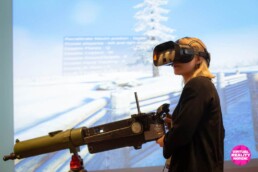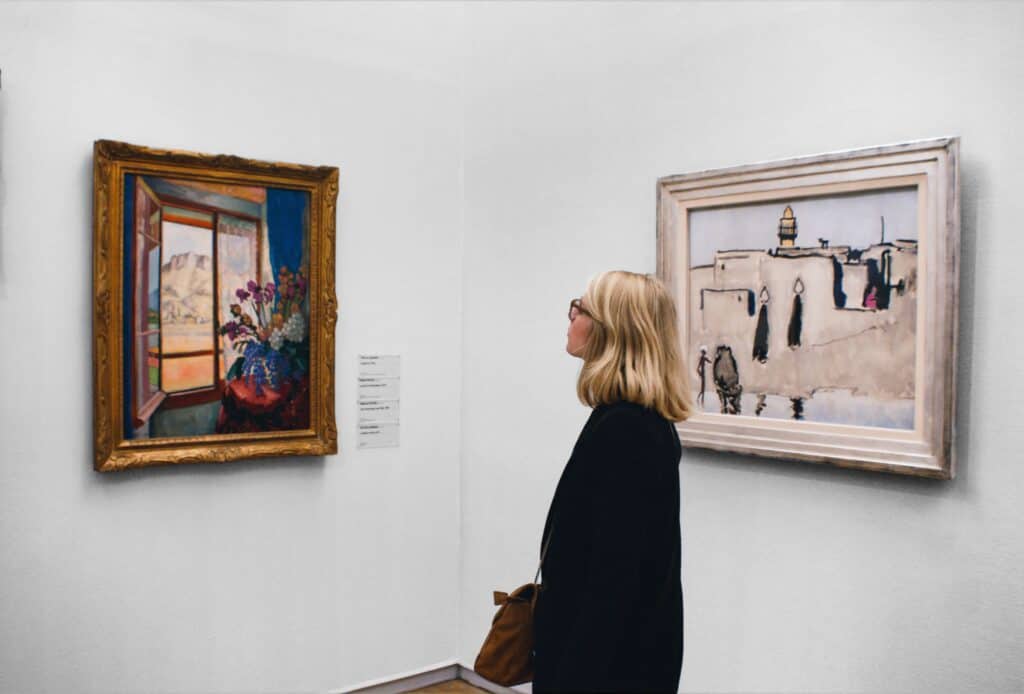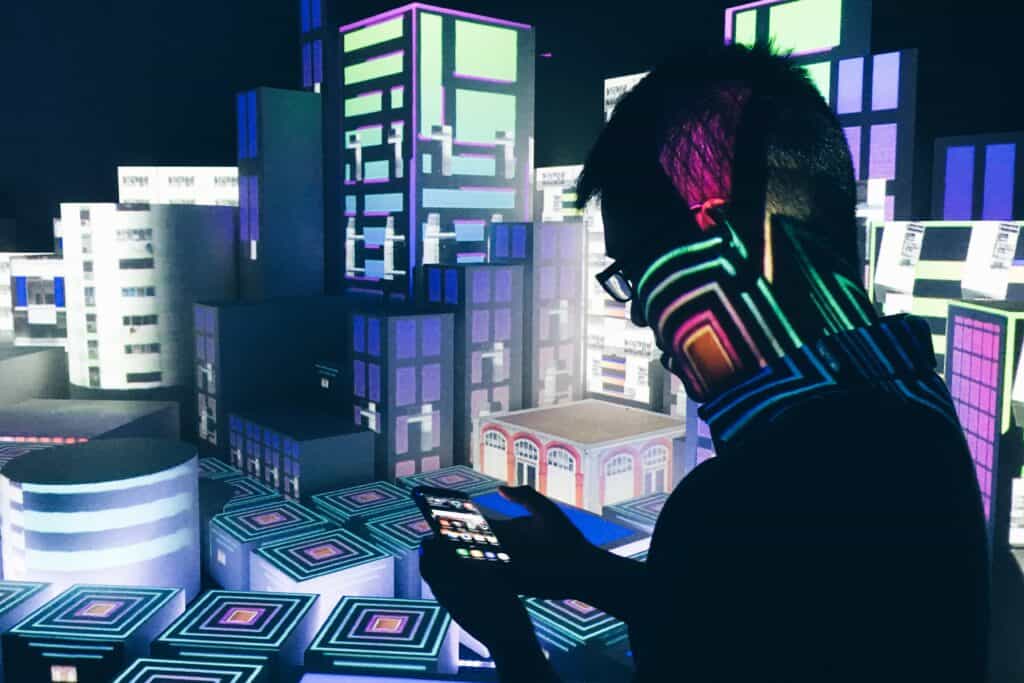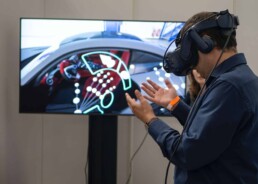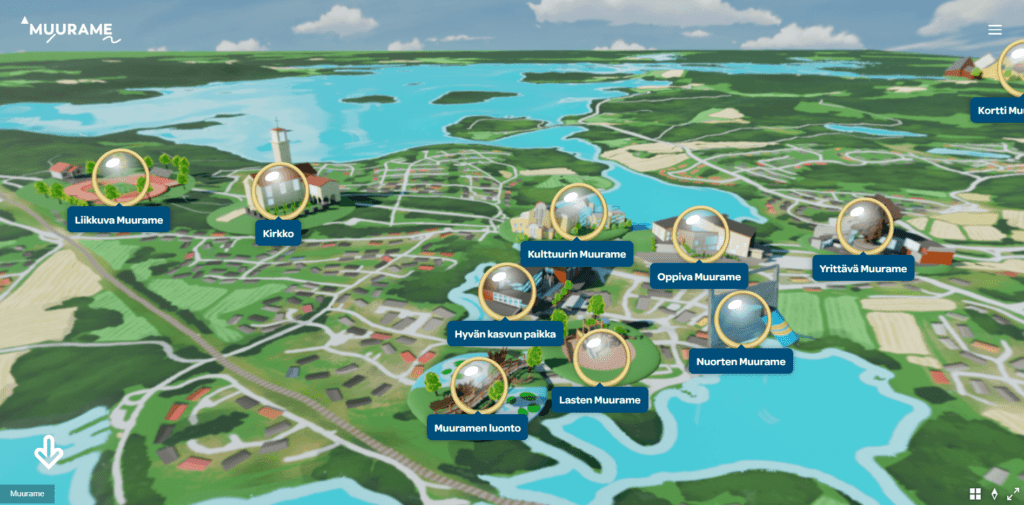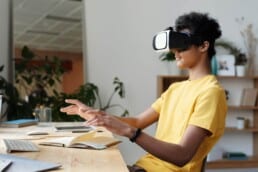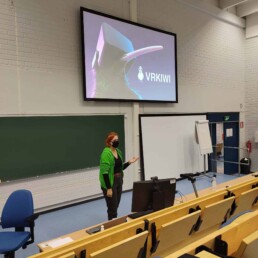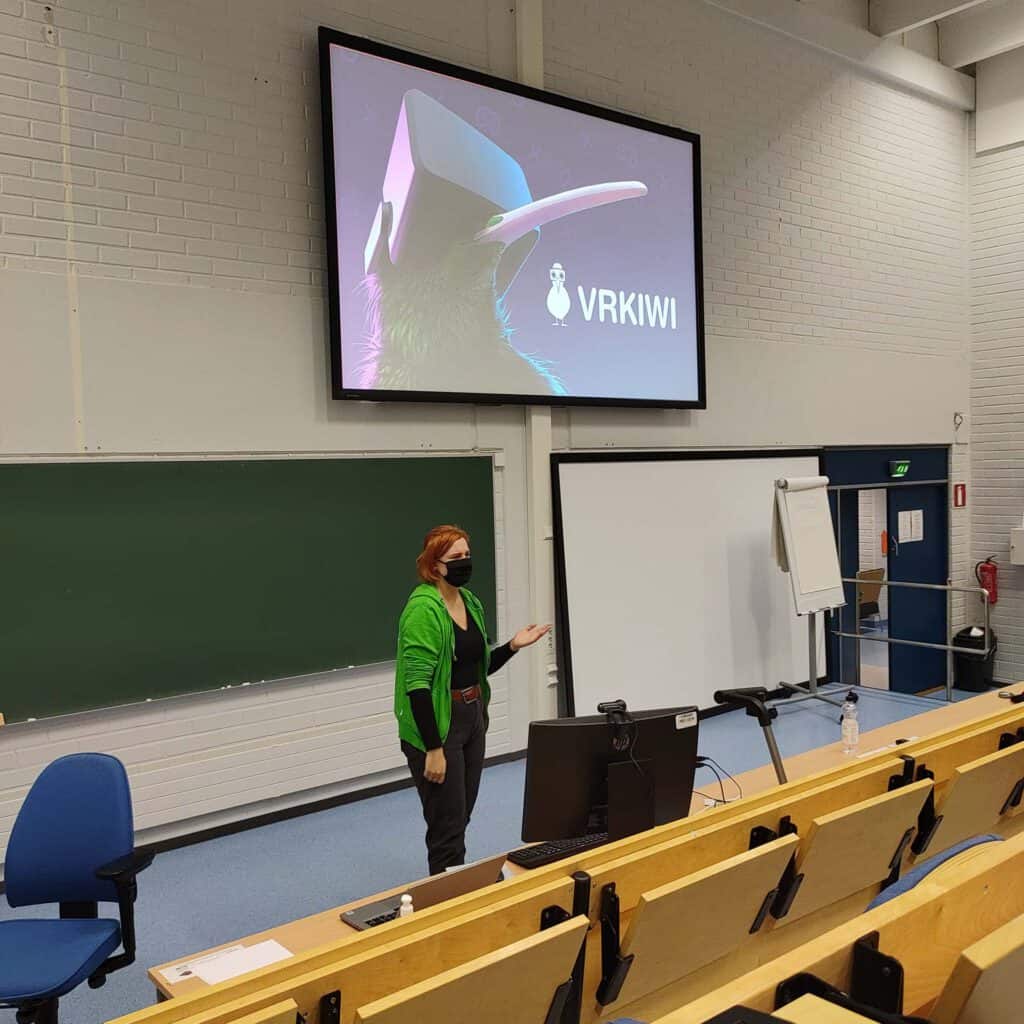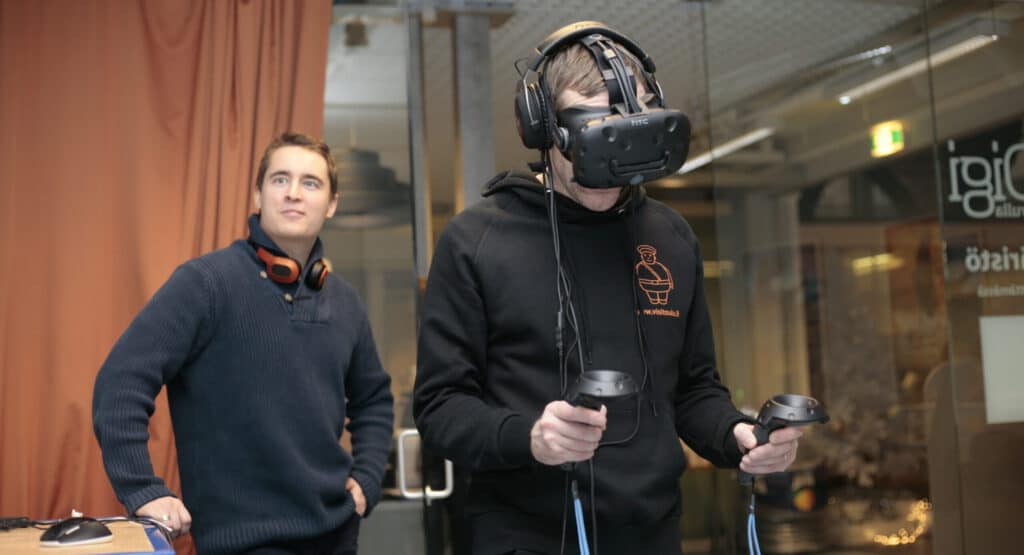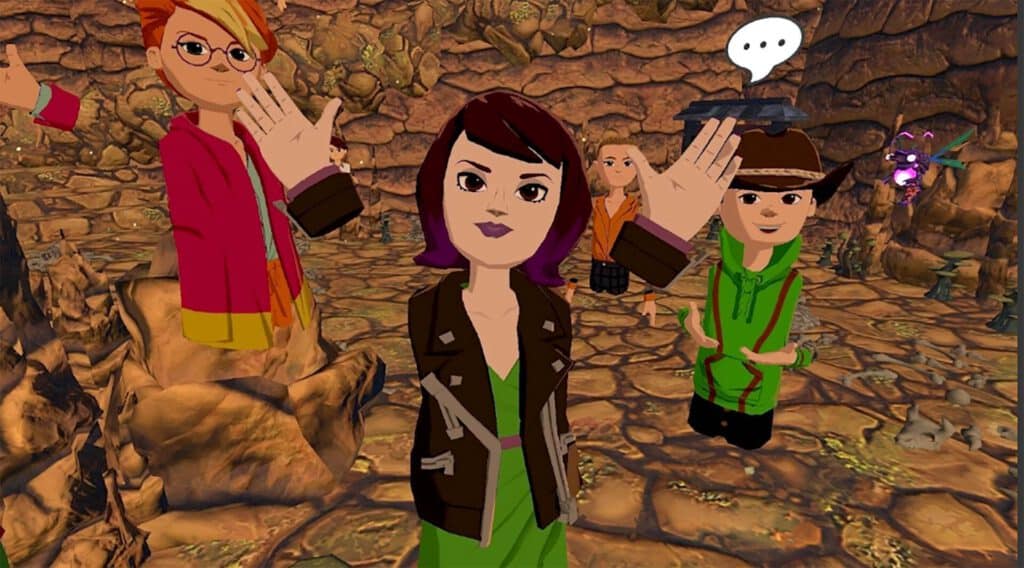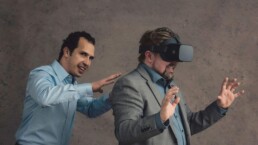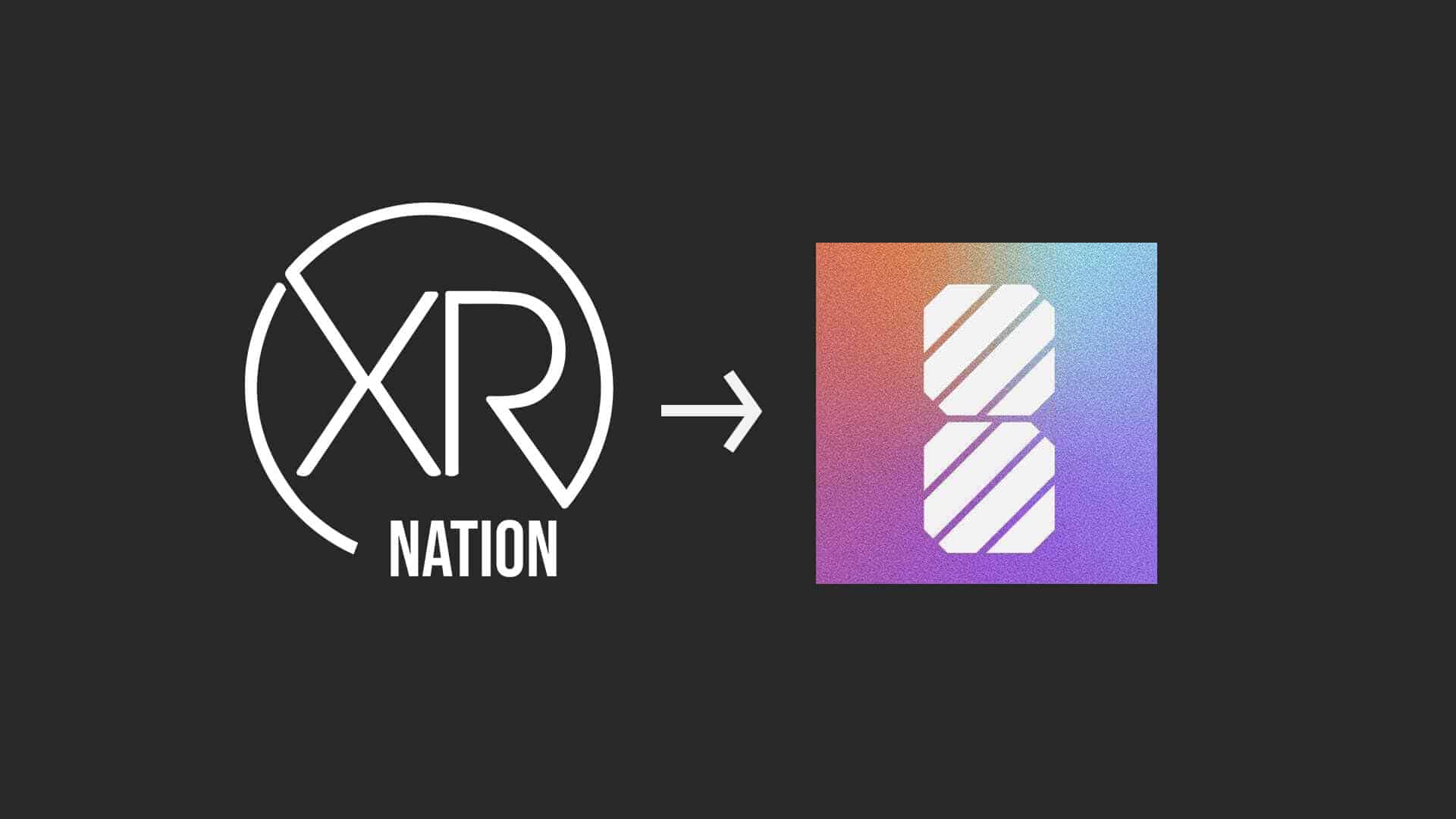Metaverse opens up for business
Game development has brought the virtual world to homes. The digitally native and global Gen Z has grown up with advanced graphics for computer games. Their experience and attitudes set high standards for the virtual user experience.
The Metaverse is the virtual world of the future. It is where people enjoy themselves, buy and work virtually. User simultaneity allows them to interact and communicate with each other in a shared virtual environment.
Metaverse and multisensory experiences
Virtuality creates new kinds of opportunities for business. The Metaverse offers customers a multi-sensory customer experience through virtual, real-time interaction.
Today, virtual reality (VR) in the metaverse is, for example, a commercial VR environment where customers can explore the products and services on offer in 3D showrooms or simulated use cases.
Customers create a virtual character for themselves, which allows them to move and chat with other virtual characters in the same space. The virtual 3D environment and models help the customer to get familiarised with the features of products and services and thus make it easier, for example, to make a purchase decision. A well-designed virtual tour reduces the customer’s product returns and the need for customer service.
VR technologies enabling the metaverse
Virtual applications enable a virtual experience of things, places, and situations that are currently inaccessible.
The goal of a VR application is to create a lifelike, virtual, customer experience, to the extent that it is appropriate. A good example of this is the Simboat VR application developed in collaboration between MeKiwi and XR Marine. The highlights of boating are present virtually, allowing the customer to discover a new boat model even before the ice starts to melt.
The technologies enabling the metaverse are AR (Augmented Reality) and VR (Virtual Reality) and the intermediate form MR (Mixed Reality). They are based on XR (Extended Reality).
In the AR experience, virtual content is connected to the real world with the help of an AR-supported application or browser. A familiar example for many is the Pokémon GO game. In it, the player searches for Pokémon characters that are connected to the real world. Additional information or instructions on a product or service that can be accessed via a QR code is also an AR experience.
In a VR application, the virtual environment is viewed with VR glasses that exclude the outside world. In the environment, you interact with objects manually or with VR controllers. Visuals, sounds, and interactions with the environment create an immersive VR experience.
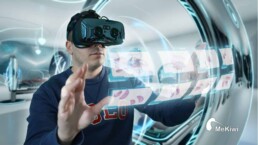
The use of the metaverse is increasing
Hyper-realistic, shared and multi-sensory virtual worlds are on the rise. The most advanced virtual environments are for business and industry. The adoption of Metaverse in the consumer market requires advances in devices, applications, platforms and connectivity.
According to Nashant Batra, Nokia’s Chief Strategy and Technology Officer, the first 5G-Advanced deployments will begin in 2025, when the coverage of the metaverse will increase dramatically. For more detailed technical information, see the guide Metaverse matters: A guide to an immersive future published by Nokia.
The metaverse is implemented by professionals
The aim of the VR experience is to achieve the immersiveness familiar from the gaming world, where the user is immersed in their VR experience. The aim is to create a VR environment in which the operating principles of the real world are reflected. A good example of a VR environment is MeKiwi’s latest VR game, Cave Digger 2: Dig Harder.
A positive user experience is created by skillful technical implementation and smooth service. The best results are achieved by a professionally multi-skilled product development team that includes software developers, graphic designers, UI/UX designers and service designers.
Want to boost your business with virtual reality? As professionals in game development and digital marketing and sales, we can help you make the most of virtual technology.
We will familiarise ourselves with your company’s needs and create an overall picture of the development project for you. We tell you what we do, how we move forward and what we achieve together.
We have been involved in the story of many customers. Check out the references and blogs on our website.
MeKiwi funding round closed and new game release in autumn
MeKiwi Oy, one of Finland’s leading developers and publishers of VR games, completed its early-stage funding round in July and is now moving with increased resources towards a new game release, which is planned to be launched on the world’s major gaming platforms in autumn 2022. The investors in the financing round are the Oulu-based Nordic Option Oy and Korpu Siemen Oy, as well as the company’s current shareholders and key personnel.
“As a company, we have a long history of working with VR games and have proven that our expertise allows us to develop and publish commercially successful games worldwide. The completed funding round will result in stronger marketing initiatives with the release of the new Cave Digger 2 game, as well as the overall development of the company in line with its growth objectives,” says Samuel Kuosmanen, CEO of MeKiwi.

“The VR content market is growing at a significant pace, especially for games, and at Nordic Option we believe that MeKiwi’s talented team has the potential to make an international breakthrough. The company’s ambitious growth targets will require the development and commercialisation of several new games in the future. The key task for the current owners is to ensure that sufficient resources are available for the development of new games alongside other strategic measures,” continues Teemu Puumalainen, Investment Director at Nordic Option.
“MeKiwi’s future plans are to increase its game publishing volumes by developing its own games, but also by publishing and marketing other developers’ games. It is also important to develop and manage the distribution channel network to ensure that the games released are accessible to customers on all major and popular platforms. In a few years’ time, MeKiwi will be hopefully a brand that everyone knows”, concludes CEO Kuosmanen.
Additional information:
Samuel Kuosmanen, CEO MeKiwi Oy, , 044-5452020
Teemu Puumalainen, Investment Director Nordic Option Oy, , 040-6318362
Matias Itkonen, Managing Partner SijoittajaPRO Corporate Finance, , 045-6721414
MeKiwi in brief:
Mekiwi is the largest developer and publisher of VR games in Finland. It also offers customised software development and web services to corporate customers. The company was founded in 2014 and its turnover has grown to over €1 million. The company currently employs around 30 people.
Nordic Option in brief:
Nordic Option Oy is a venture capital fund investing primarily in growth companies in Northern Finland. Its largest owners are Arvo Sijoitusosuuskunta, Partnera Oyj, and the City of Oulu. The goal of the company is to offer a nordic option to facilitate the growth and internationalisation of small and medium businesses.
Korpun Siemen in brief:
Korpun Siemen Oy, founded by SijoittajaPRO Corporate Finance, is backed by 33 early-stage investors with extensive experience in start-up, growth and family-owned companies in various industries. The company includes active angel investors, growth company entrepreneurs and investors who have already exited their companies.
How extended reality (XR) brings value to museums
XR is an umbrella term that covers virtual reality (VR) and augmented reality (AR). Visiting museums and exhibitions can be both fun and educational. Thanks to XR technology, it is possible to create real-world experiences and get closer to history and art in a fun and immersive way.
XR takes the exhibition to a new level
XR offers a way to bring the exhibition to life in a whole new way. Virtual reality, for example, allows a user to travel in the middle of a natural site where they can view different species of animals in their actual scale, such as tigers or bears in their own habitat or see already extinct animals.
A visitor can be taken on a trip to a historic site to explore for example what the Colosseum used to look like a long time ago. More information about works of art can be presented with augmented reality, or sound effects or music can be added to them. Virtual reality allows the visitor to be creative and create their own art or to interact with existing artworks, for example editing them as they wish.
Alternatively, the whole physical exhibition can be brought to virtual reality, which in itself opens up completely new possibilities. In the museum, however, XR’s purpose is to support the exhibition and not just steal the spotlight.
XR enhances learning
Learning can sometimes be experienced even as challenging or dull, but museums provide an excellent learning environment for all ages. The interactive works enrich the visitor’s experience of the exhibition, and XR enables the visitor to participate and immerse themselves in the exhibition even better. A more intense experience is more impressive and there have been studies that XR also helps to recall what a person has experienced or learned more easily than without XR, this is especially useful for educational purposes.
Examples of XR used in museums
Many museums abroad and in Finland have utilized XR technology in their exhibitions. A well-known example is the Louvre, where visitors were able to explore famous paintings in more detail and how they had changed over time using virtual reality. The Finnish National Museum has also previously introduced virtual reality in an exhibition where visitors could step inside the painting and communicate with the characters in the painting.
MeKiwi’s XR projects
MeKiwi has created a fully immersive demo of Finnish Winter War VR-experience, known as “Operation Suentassu”. The project started when a new war museum was starting in Mikkeli and we were offering our services for a war VR experience. The intention was to create a realistic, short segment teaching about the horrors of war without it being a too raw experience. This demo project utilized the latest Mixed Reality technology, creating a mix of real and virtual worlds. The project utilized the newest VR-technology and authentic, deactivated Suomi KP/-31 as a controller instead of a traditional VR-controller. With this experience one can relive history that makes them feel like they are physically there.
We also implemented a virtual museum for the municipality of Muurame, where the user can view spaces as a 360° environment, most of which are based on actual places in Muurame. The user can for example visit Muurame church and view the choir performance in a 360° environment. The project was implemented in honor of the 100th anniversary of the municipality of Muurame and aims to present services, recreational opportunities, diverse nature and history of Muurame.
Contact us if you are interested in the topic or want to hear more about what kind of XR solutions we can offer.
MeKiwi showcase for the Sapporo xR Exhibition
MeKiwi participated in the Japan Sapporo xR Exhibition 2022. Our expert Merih Arikkök provided a quick overview of MeKiwi’s skills and services, showcasing previous customer cases and references.
As extended and immersive reality solutions can be successfully employed in many different areas, the examples provided in Merih’s presentation covered a wide range of sectors.
Learning solutions and training simulations
As an educational prototype we developed Histology XR, an innovative healthcare learning experience in XR for medical staff, students and lecturers.
With this tool, users can study microscopic images & samples in an immersive virtual environment, with the freedom to zoom in, seamlessly switch between samples, collaborate with others and teach peers.
It uses “true eye view” technology, eye tracking and hand tracking, features of the world’s most advanced Mixed Reality headset, Varjo XR-3.
Another example provided of a learning solution in XR was the security personnel training simulation created for the OSAO vocational school. Since students couldn’t attend school in person during the pandemic, MeKiwi helped overcome this challenge by bringing practical training into the students’ homes through virtual reality.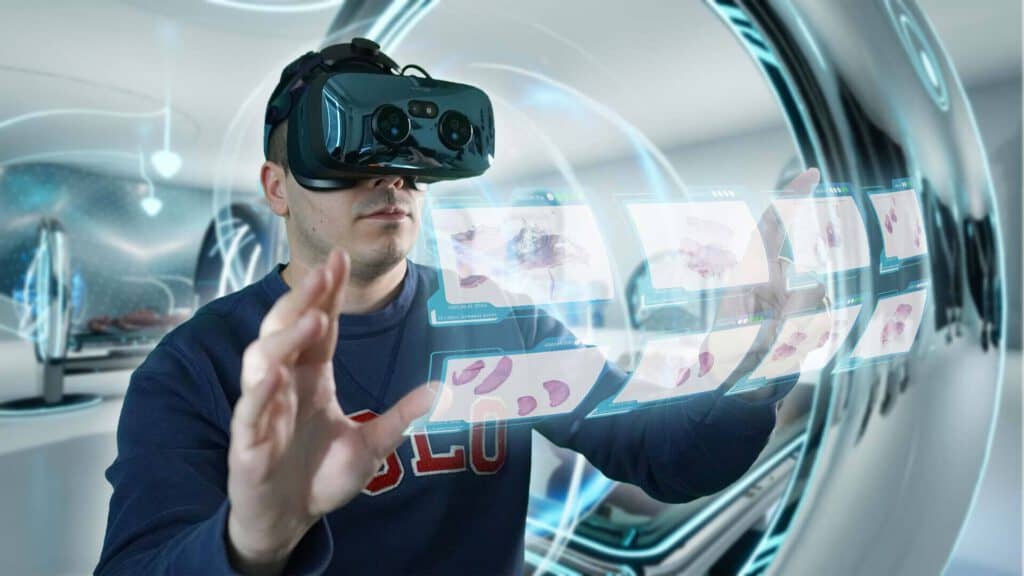
Entertainment, education and tourism
The other showcased projects could all bring added value to entertainment, education and tourism areas.
This is the case for Operaatio Suentassu, a fully immersive Finnish Winter War Mixed Reality experience. It was developed using Varjo XR-3 and HTC Vive Tracker in MR where the user can handle the actual gun, a deactivated Suomi KP/-31, and see it and use it as a controller in game.
We also worked on an immersive boating simulation that was created for the Finnish company XR Marine. We 3D modeled an original motor boat based on the company designs and included it in an immersive XR experience.
The last example for XR uses in tourism was the AR experience for the city of Muurame, Finland, where by visiting the local church in AR the users can watch the kids’ choir sing. Also links to the city’s virtual museum and services were included in the application.
More than meets the eye
Using any type of extended reality solely for gaming purposes would be limiting to the actual capabilities of the technology.
It is no surprise that learning by doing helps retain information more than a frontal, passive, type of lesson, and “living” in an historical event is more impactful than reading about it.
Wanna be inspired by some of our previous works? You can find them here. If you want to bring your project to the next level with XR contact our Customer Success Manager Jonna or our XR Expert Merih.
How the travel industry can benefit from XR technology
You may be familiar with XR technology and how it is used in the gaming sector, but many other industries can also benefit from it. In this blog we briefly concentrate on how the travel industry can utilize XR.
What does XR mean?
Extended Reality (XR) is a term that refers to all the immersive technologies, such as virtual reality (VR), augmented reality (AR), and Mixed Reality (MR).
Digital visibility is vital to companies and what could be better than XR technology and its endless possibilities and scalability. Utilizing XR technology also gives the company a competitive edge on social media by creating more interesting content for the visitor. Especially after corona restrictions, we had to adapt to a “new normal”, which inevitably increases XR technology and virtuality in general.
XR technology and travelling
XR technology can be used, for example, in the marketing of a travel destination. Many travelers search a lot in advance about different travel destinations and their attractions and activities. In this case, marketers can create a 360° video of the destination that the end user can view even in their own living room. When an user has better and more extensive access to exploring their destination in advance, they are much more likely to book that trip, compared to a trip or destination where there is not enough information available. The traveler can navigate the desired route or attractions in advance, which will save them time. This also helps the traveler to choose the right destination for them and helps to plan the trip, for example, in terms of equipment. In addition to the destination itself, the accommodation/hotel can be marketed as well.
Virtual tours could also be created especially when traveling to a destination is physically inconvenient or otherwise restricted. With XR technology, the visitor gets much more out of the trip, they can explore more destinations or focus on one more intensively. Thanks to the latest technology, virtual travel destinations or virtual elements embedded in the physical world are even more immersive.
Technology in the middle of nature and in the city
XR technology can be utilized both on nature trails and in the middle of the city. In both cases, the XR can be used to provide information about the environment to the user, whether it is a type of tree or animal species or, for example, a statue or some other area or object.
For example, a user can scan a statue or even a QR code using their own phone to display information about that place on their phone screen, by text, video or an audio track, all of these can be combined as well. How does it sound to view a place through the eyes of history? You are physically present in a modern environment and at the same time you can view how that area looked like a long time ago.
MeKiwi has developed many extended reality projects. For example, the Digimuurame.fi multimedia website that MeKiwi created for the municipality of Muurame allows users to visit the Muurame Church, listen to the choir in an augmented reality, or even go on an adventure with a canoe and mountain bike in Muurame’s nature via 360° video experience. MeKiwi has also implemented an AR application called “Oulujoen ympäriajo” for a thrilling orienteering experience in cooperation with Oulujoki School’s students and teachers. Among other things, the app helps promoting student participation and creativity.
From an idea to the solution
In April 2022, Business Finland organized a funding application to support sustainable growth and digitalisation in traveling, which implements Finland’s Sustainable Growth Program, which aims to build a greener and more digital society. The purpose was to highlight how to make a tourist stay longer, the year-round tourism and traveling and new customer groups. XR solutions can meet these needs.
If XR technology was a previously unknown topic, you can read more on MeKiwi’s website and contact our account manager Jonna Ranta or our XR expert Merih Arikkök.
Meta- Metaverse, Better Business Solutions with Modern Technologies
The Beginnings
Facebook’s recent rebranding as Metaverse (Meta) has made the concept popular, but the term existed long before this. “Metaverse” is first mentioned in Neal Stephenson’s novel Snow Crash. The story depicts a virtual reality world run by a monopoly corporation that wants to control the lives of the service users.
Social media has proven to be an excellent tool for businesses to find new customers, promote sales and build trust and loyalty with customers. Mark Zuckerberg’s focus on Metaverse aims to take us to the next level of an internet that works in virtual reality. Users can work and play in the online virtual world and, through it, connect to each other, to products and games in a more immersive way than ever before.
What Technologies Make Up the Metaverse
The Metaverse consists of interconnected virtual worlds that exist even when there are no users online. Users can connect to these worlds with virtual or augmented reality glasses, for example. In virtual reality, the user is fully immersed in the virtual world, and in augmented reality, the virtual world is drawn into the normal world, allowing the user to navigate both simultaneously.
The Metaverse also includes a digital economy where users can create, buy and sell goods. In futuristic scenarios, the worlds would be so compatible that users could take virtual objects, like clothes or vehicles, from one platform to another. In the real world, you can buy a shirt in a shopping centre and then wear it in a cinema. Currently, most platforms have virtual identities, or avatars, that are tied to only one platform, but the Metaverse can allow you to create a personality that you can bring anywhere as easily as you can copy your profile picture from one social media to another.
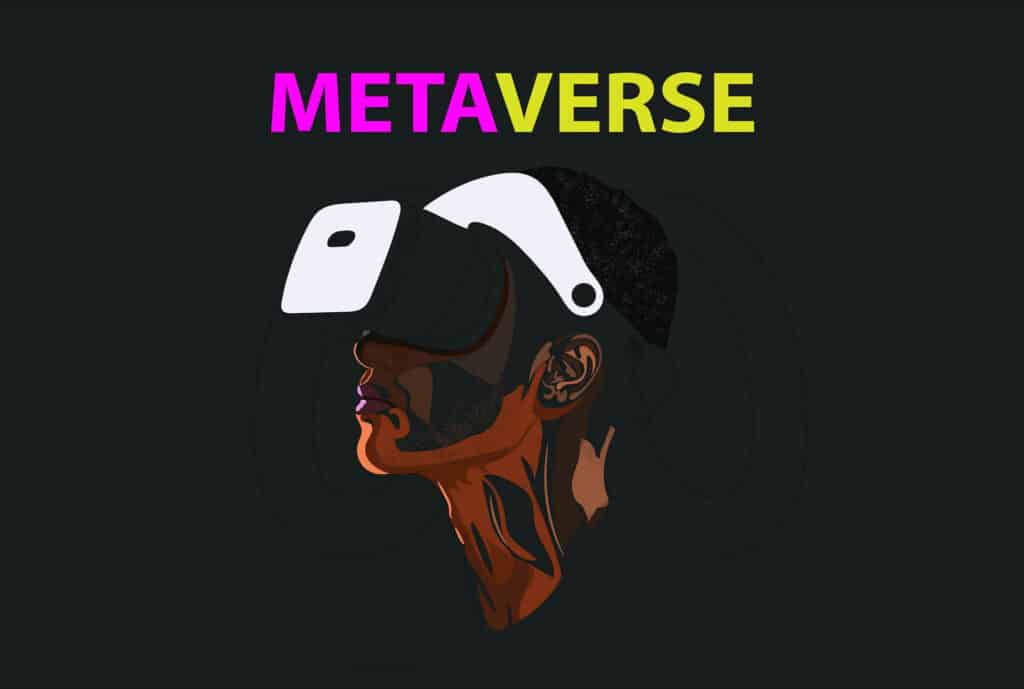
The Role of Transparency
In the “rules of the Metaverse”, Tony Parisi says that the Metaverse should be an open source project built for everyone without anyone controlling it. The current Internet works with these rules, and since the Metaverse is a more immersive version of it, it should therefore be built on similar foundations.
It would be important for business owners and decision makers to understand the technologies that are driving Metaverse forward and what impact they may have on the users, the environment and our society. By understanding these technologies, companies can find new ways to enrich our society through the constructive uses of virtual reality connectivity that develop our world and keep the digital economy thriving.
Nature of the Metaverse Content
Understanding the technologies that enrich the Metaverse is in the interests of companies, as they can bring benefits to the business, such as a better customer or user experience, more efficient processes, better security and more immersive entertainment.
Companies also need to understand that as the Metaverse landscape evolves, the nature of the content will also change. Creating quality content marketing strategies with these immersive virtual environments in mind is essential as the industry progresses.
At its core, the Metaverse is defined by being an immersive experience for users, and this would not be possible without AR and VR technologies. The terms Metaverse and VR are often used interchangeably, but there are differences. The Metaverse is meant to be an interconnected VR experience. When the user accesses the Internet communities in the form of an avatar, the definition of Metaverse is met. In the future, the Metaverse may expand to other futuristic technologies. AR and VR are the cornerstones of Metaverse projects. Augmented reality systems use three elements together: real and virtual environments, real-time interaction and accurate 3D visualisations.
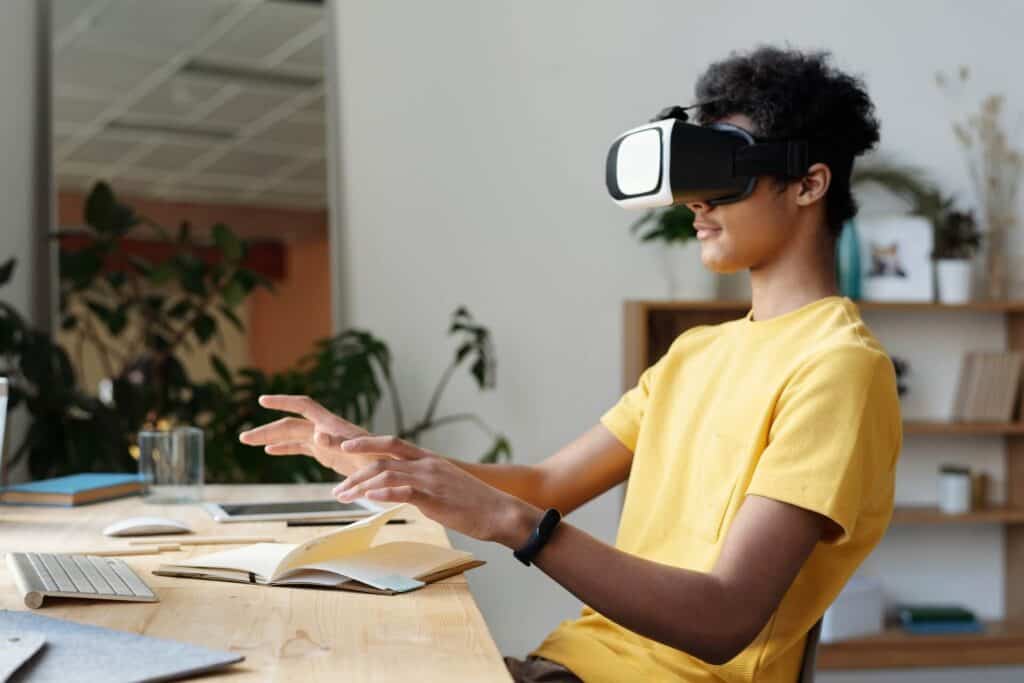
Ethics and Responsibility
If we consider technologies ethically and responsibly, we can find ways to truly help customers by growing their business. These technologies aren’t meant to replace the real world, but instead expand the understanding of the internet and share experiences in ways that weren’t possible before.
Interview with Riikka Kilpeläinen, MeKiwi AR/VR Project Manager - How Riikka chose a career in technology
On 12th of October we celebrated Ada Lovelace, known as the first computer programmer, and all the achievements of women in science, technology, engineering and mathematics. We had a chat with our AR/VR project manager Riikka Kilpeläinen for the occasion.
Tell us something about yourself?
I'm a project manager at our B2B department, so I handle our VR/AR/gamified projects at MeKiwi. When I'm not doing project management, I'm most likely doing Unity programming. I'm also involved in VRKiwi's porting and publishing side. I've been working at the company since late 2020 and I did my internship here as a VR Unity programmer
What led you to this field?
I've played games as long as I can remember (like many people who work on games) and even if game development, or even software development wasn't my first career choice, I've always been interested in computers. When I was studying fashion, I was really interested in computer graphics and drafting patterns digitally and such. So it was really a no-brainer, that if I decide to switch my plans for the future I'd end up in software development. Eventually I got into an university of applied sciences that had a degree in game development, and the rest is history. I like everything (okay, most things) about game development, production, art, programming, publishing, marketing, and I have to say I love the process behind the making more than anything. So as long as I can make some sort of interactive, possibly game-ish software, I'm happy.
What are the challenges you face/faced?
Feeling a bit lost at times, for sure. When everything seems exciting and something you'd like to learn more about and try out, it can be hard to know what's really your thing. I've had to accept that being a generalist is also a position that needs to be filled in many companies, and it's especially useful to know a bit about every area of game development as a project manager.
What’s the coolest project you worked on?
This is a hard one, since every project has its ups and downs and all of them have something cool that's completely unique to the project. But I'll have to say my favorites are always the ones where we overcome some obstacle together with the customer. Since our customers are usually not game developers themselves, they'll have a completely different skillset and I get to learn something completely new about a different industry. Which might not help me with my generalist "problem", I get really excited about whatever industry we're working with and I'd like to indulge myself in that for a while!
Outside my work at MeKiwi, I worked on multiple games, mostly at KAMK. Each of those taught me so much about game development and especially about teamwork. I feel that the project I'm currently working on is always the coolest and my favorite, so it's hard to give an unbiased answer!
What’s your dream project?
I like limitations set by hardware or other factors, which is one of the reasons I ended up working with virtual reality. I also like heavily stylised graphics and the challenges their workflows bring. So my dream project would be a real artsy-looking game, that heavily focuses on the artstyle and leans into the strengths of the style. I'd love to get to work as an art lead again or a technical artist of some sorts. A diverse team is a must, with everyone bringing their expertise and past experiences to elevate the project even further. As you can see, I'm more of a process-oriented person than someone who'd like to create a game in a certain genre or platform, haha.
Any tips for anyone who’s interested in this career?
You've probably heard this a million times but if you want to be a game developer, you just have to make games. This doesn't mean that you have to have a big team and a company behind you, just that you need to create. My portfolio is full of tiny games I've made by myself within a weekend, so game jams are a great way to get motivated. One big part many people forget about game development is that you'll need to finish your games eventually, and game jams are a great way to learn that as well! So if you're a complete newbie, jams let you experiment on a small scale and hopefully make some connections along the way.
VR technology in communication
Virtual reality has always been an interesting technology with an unique potential for many reasons, but remote work needs and the introduction of the "metaverse" are probably the top two reasons VR is now a key component of communication.
Enhanced remote meetings
VR technology can be utilized, for example, in corporate meetings that can be held in virtual reality. Meetings in virtual reality are at least as effective as those in live because it feels like you’re really in the same room with others, so communication is effortless.
The immersive environment created by virtual reality also helps participants focus more on the meeting. This can also be used in various trainings, making the training situation much more comprehensive and effective.
Personalization and customizability
In the VR world, users could create and edit their own personalized avatars. These avatars can be used as an aid, for example, in various networking events. You can add any personal information you want to your avatars, even your own name and a description of your own skills.
Data visualization
Many of us are visual learners, so wouldn’t it be great to get to explore data in an even closer and easier-to-understand format? The virtual 3D environment allows this and also the ability to interact with the data. This can be used, for example, in meetings to present important data.
Ask us more about how virtual reality adds value to your business, send a message or call our AR / VR Account Manager Merih.

Interview with Joh Orengo from XR Nation
There's strength in numbers and Joh Orengo knows that, as he's one of the people behind XR Nation. XR Nation is the most important and biggest hub for extended reality (XR) related companies in the nordics. We interviewed Joh to see how the situation of extended reality is in Finland and internationally, what kind of cool stuff people can achieve with these new technologies and what's in the future of XR Nation.
Tell us something about you
I'm a Puerto Rican living in Finland for 12 years now. I came here for university where I met my future wife and decided I didn't want to be anywhere else. Now I'm the CEO and Founder of Spatial8. I've been part of the XR scene since 2018 when I joined the AR startup Grib. Before that I used to be an English teacher at the University of Helsinki for about 6 years but decided to switch careers. It was time for a new challenge. But for what I'm doing now 'challenge' is a bit of an understatement.
What does XR Nation do?
XR Nation is a modern business ecosystem of XR companies from across Europe. (It's the auxiliary name for Spatial8). We offer consultation through workshops to help educate brands about the technology and how it might be able to help them meet their business goals. We then connect them with the best companies for content creation and other services and AR or VR products. We also run an internal market where ecosystem members can buy and sell their products and services, some of which are not offered publicly, to each other at member rates.
How many members do you have?
54. We're the largest ecosystem of its kind in the Nordics, and once we hit 71, we’ll be the biggest in Europe.
What are some business cases that came out of the ecosystem?
We have a partnership with Telia to run their content creator ecosystem for their "AR by Telia" platform. A number of our business cases come from that pipeline. For example, one of our members, Make Helsinki (now Healthware International) created AR recipes for some of Valio's dairy products. Another example is MeKiwi creating a fun face filter for a Finnish taxi company that wanted to promote the change of its phone number. Apart from the AR by Telia business cases, we have several municipalities approaching us to take part in various XR-related projects.
How’s the XR panorama in the Nordic countries and especially Finland?
Finland is an exciting place to be for XR. We have one of the best startup ecosystems in the world. There are active XR communities in Helsinki and other cities, like Jyväskylä and Oulu. Not only is Finland's gaming ecosystem top notch but now we're making a name with VR games like VRKiwi's Cave Digger, one of the most popular games for the Oculus. We have a new photonics association and startups like Dispelix and, of course, Varjo pushing the limits of XR lenses and Mixed Reality headsets. AR companies make a lot of noise, too. Grib has won multiple awards for its 3D modelling software and Immersal was recently acquired by the Swedish company Hexagon for its mapping technology. Anarky Labs is also creating a revolutionary AR interface for professional drone pilots.
If we look at the rest of the Nordic-Baltic region there is also a lot I could say. Here is a snapshot. Flow's popular VR meditation software utilizes Iceland's nature as its backdrop. Norway has quality research and practical applications about immersive learning coming from local universities and the VRINN business cluster. Sweden has a heavy hitter in Vobling that's part of the publicly listed entertainment conglomerate Bublar. Denmark is home of MeetinVR, one of the best virtual collaboration platforms out on the market today. Estonia's Wolf3D has recently released a hub for its cool cross-platform avatars, and the EdTech startup Futuclass creates quality courses for teaching math and science in VR. Some XR, media, and gaming ecosystems joined together in Lithuania to improve business and innovation. Latvia also has a young and exciting XR community helmed by the founders of Overly, an experienced and creative AR company creating its own platform. I can go on, but then it wouldn't be a snapshot. Suffice it to say, there's a lot of outstanding work coming out of the region.
Which field uses XR technology the most? Which ones will see an increase in XR use?
If we look at Augmented Reality, marketing and advertising is a good entry point for a brand to see how the technology can be used to attract customers and gain insights into their behavior. This could be the beginning of a broader "XR strategy". A company like the dairy producer Valio, for example, who I mentioned earlier could also utilize 'enterprise AR' for maintenance and operations as well. While AR advertising might be the 'low hanging fruit', AR, especially as headsets improve, is really showing its capabilities and will continue to be used more and more in warehouses and factories and on the farms.
A place of great interest for us in particular is VR for learning and training. VR has been applied to training in the university and R&D setting for decades now. Entrepreneurs and creators should not only be aware of the foundations they are building on but also could avoid some wasteful mistakes by learning our history and getting to discuss with the early innovators, who are still very active in the field.
On top of that, we in the Nordics and in Europe more generally could benefit from learning about what our neighbors are up to as well. In XR Nation's network alone there are three companies producing complementary 360/VR platforms that could be used for training. We don't see that as a bad thing. What can be done in this situation and what role can Spatial8 play? We'd like to explore that. We believe the Nordics have a chance to really push ahead in VR training.
What kind of XR events are being held?
I'm the founder and co-organizer of AWE Nite Northern XR (previously known as AWE Nite Helsinki). It's a branded meet-up under Augmented World Expo (AWE) designed to bring the XR communities in the Nordic-Baltic region (collectively known as 'Northern XR') closer together and showcase the companies coming out of the ecosystems. One of the meet-ups focused on XR for fashion. My business partner Teemu Ollilainen and I saw that there was so much interest in that topic that we decided to explore what we could do in the field.
I brought together two of that meetup's participants, Olesja Hännikäinen and Krista Jäntti, and together we came up with Exthereal, the company behind an online conference that brings the XR and fashion worlds together. Our first event, which MeKiwi will be taking part in, will be early this December and sponsored by Accenture and Microsoft. More information about the event will be coming soon!
What goals do you have for the future of XR Nation?
We are currently changing brands to Spatial8. While we began with XR Nation, its community, and their AR and VR products and services, we aim to adapt that model for blockchain technology companies. We need to embrace the technology that could one day make us obsolete and learn how to adapt it wisely.
That is what 'spatialate' means, to improve something or solve problems through the judicious application of emerging technologies. And it doesn't stop at Blockchain.

A data wing is also in the works. As part of that wing we hope to build stronger bridges to the AI ecosystems in Finland, the Nordics, and the rest of Europe. S8 also works with Kaira Clan as our gateway to the Finnish IoT ecosystem.
These are some examples of the emerging technologies and companies that we are bringing together to help better educate the market, solve business problems, and promote innovation.
In short, we want to spatialate the world.
The Oulu-based technology company MeKiwi presents a new VR technology - the first project simulates the Winter War
The Oulu-based technology company MeKiwi has created a completely immersive VR experience set during the Finnish Winter War called “Operaatio Suentassu”. It was developed using the Varjo XR-3 and HTC Vive Tracker, while the controller is a real deactivated Finland KP/-31 submachine gun. With this experience, the user can relive historical events and feel physically there. This type of technology can be applied, for example, to teaching or creating various experiences.

This kind of technology can be used for any kind of educational purposes, for example teaching CPR skills or working with specialised machinery. One can simulate any physical object and create an immersive, interactable situation in Virtual Reality and Extended Reality. Any kind of museums, science centers, educational institutes and specialised workplaces in general can take advantage of this tech.

"On the software side we already had the Talvisota experience but I wanted to include more action - so we added tanks, artillery, airplanes and waves of incoming soldiers" says Jaakko Asikainen, MeKiwi's Chief Technology Officer.
”It all started small. A new war museum was starting in Mikkeli and we were offering our services for a war VR experience. The intention was to create a realistic, short segment teaching about the horrors of war from the point of view of a single soldier. But why create a generic VR experience with the normal controllers when we could be using actual physical guns as controllers? So we took up the challenge and started creating a replica of the machine gun Maxim M/09-21 used in the Winter War, which was a variation of the famous Maxim machine gun. Operation Suentassu was a direct continuation of the Maxim project, but this time we used an authentic deactivated weapon” says Jaakko Asikainen.
About MeKiwi
MeKiwi is a full-stack digital agency founded in 2014 in Oulu. MeKiwi offers customized digital applications, marketing consulting, AR/VR/XR solutions and a wide range of services to meet all your technology needs. "Our company is multicultural and diverse in its skills, which allows our creativity to flow from very different perspectives, helping us to better understand the customer's vision and provide the best possible solution."
Contact person for more information:
Begüm Doğan
Marketing Lead
Mekiwi.org




